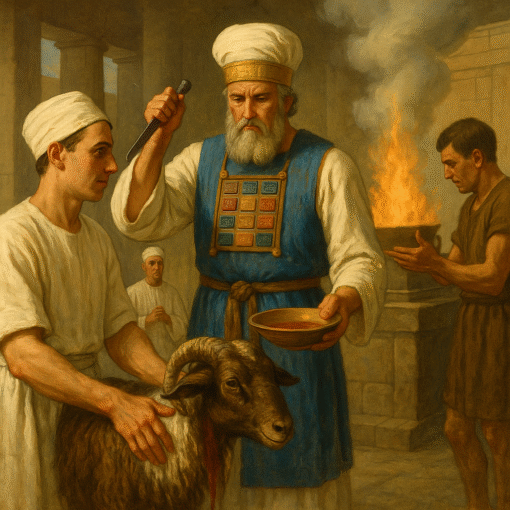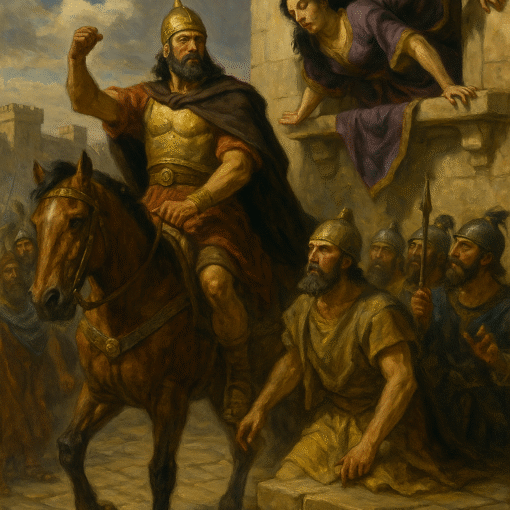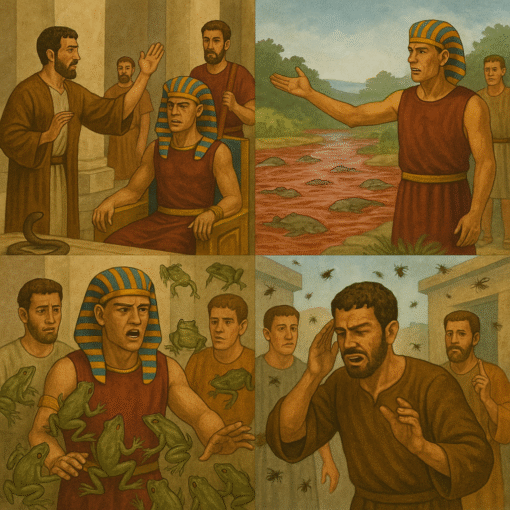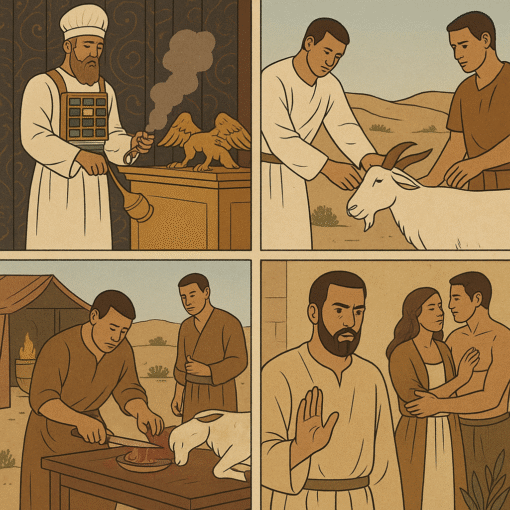The four horses in Revelation 6 (KJV) appear when the Lamb (Christ) begins to open the seven seals of the scroll. Each of the first four seals brings forth a horse and rider, often called the Four Horsemen of the Apocalypse. Here is a breakdown:
1. The White Horse (Revelation 6:1–2)
-
Description: A rider on a white horse with a bow, given a crown, who goes forth “conquering, and to conquer.”
-
Common Interpretations:
-
Christ / the Gospel: Some see this as symbolizing the victorious spread of the gospel (compare Revelation 19:11, where Christ rides a white horse).
-
Antichrist / False Peace: Others believe it represents a counterfeit of Christ, pointing to the rise of Antichrist or deceptive conquest at the beginning of the Tribulation.
-
2. The Red Horse (Revelation 6:3–4)
-
Description: A rider on a red horse, given a great sword, with power to take peace from the earth, causing men to kill one another.
-
Meaning: Represents war, bloodshed, and violence. After conquest (white horse), comes widespread conflict and bloodshed across nations.
3. The Black Horse (Revelation 6:5–6)
-
Description: A rider on a black horse holding a pair of balances (scales). A voice declares the high cost of food: “A measure of wheat for a penny, and three measures of barley for a penny; and see thou hurt not the oil and the wine.”
-
Meaning: Symbolizes famine and economic hardship. Basic food is scarce and expensive, yet luxury goods (“oil and wine”) remain untouched, suggesting great imbalance and suffering.
4. The Pale Horse (Revelation 6:7–8)
-
Description: A rider on a pale (ashen/greenish) horse, named Death, and Hell follows with him. Authority is given to kill with sword, hunger, death, and beasts of the earth over one fourth of the earth.
-
Meaning: Represents death in its many forms—war, famine, pestilence, and wild beasts. It shows the devastating culmination of judgment in widespread mortality.
Summary
The four horses together portray the beginning of God’s judgments in the Tribulation:
-
Conquest / False Peace (White),
-
War (Red),
-
Famine (Black),
-
Death (Pale).
They mark the progression of human rebellion and divine judgment, setting the stage for the later seals, trumpets, and bowls.
How several well-known conservative commentators understood the Four Horsemen in Revelation 6.
Matthew Henry (1662–1714)
Matthew Henry saw Revelation mostly as a spiritual history of the church, so he interpreted the horses symbolically:
-
White Horse – The purity and victorious progress of the gospel in the early church age. Christ rode forth conquering through His Word.
-
Red Horse – Persecutions and bloody divisions that arose in the church, where peace was taken away by tyrants and enemies of the faith.
-
Black Horse – A time of spiritual famine, ignorance, and heresy in the church. The scarcity of true doctrine contrasted with abundance of empty ritual (“oil and wine”).
-
Pale Horse – A time of heavy judgments where death came through war, famine, pestilence, and persecution. Henry ties this to decline and decay in later church history.
Summary: Henry applied the horsemen to the spiritual history of Christianity, not just end-time judgments.
John Gill (1697–1771)
Gill, a Baptist expositor, leaned heavily on historical fulfillment:
-
White Horse – He leaned toward this representing the gospel going forth powerfully in the first century, under the apostles, conquering paganism.
-
Red Horse – Civil wars and bloodshed that afflicted the Roman Empire, particularly under emperors who persecuted Christians.
-
Black Horse – Times of famine and economic distress in the empire, especially in Judea and surrounding areas.
-
Pale Horse – The destruction brought by Rome’s decline, pestilences, wars, and other judgments.
Summary: Gill linked the horses to Roman history and judgments, with strong application to the early centuries after Christ.
C. I. Scofield (1843–1921)
Scofield, known for the Scofield Reference Bible, interpreted Revelation dispensationally and futuristically:
-
White Horse – Not Christ, but the rise of a counterfeit “Christ” (Antichrist) at the beginning of the Tribulation, who goes forth in conquest promising peace.
-
Red Horse – Worldwide warfare breaking out after the false peace.
-
Black Horse – Worldwide famine and economic collapse during the Tribulation.
-
Pale Horse – Death on a massive scale — war, starvation, pestilence — claiming a quarter of earth’s population.
Summary: Scofield saw the four horsemen as future events in the Tribulation that immediately follow the rapture of the church.
Comparison
-
Henry: spiritualized / applied to church history.
-
Gill: partly historic fulfillment in Rome.
-
Scofield: futurist, literal Tribulation judgments.
-
All agree: the horses represent progressive judgments — conquest, war, famine, death — but they apply them differently (church history vs. Roman history vs. future prophecy).
The interpretation of the Four Horsemen really depends on which school of prophetic interpretation a person belongs to. Here’s a breakdown:
The Four Major Approaches
1. Historicist
-
View: Revelation is a sweeping panorama of church history from John’s day until the end.
-
Application of Horses: Each horse represents a period in church or world history (e.g., Roman Empire decline, church corruption, Reformation, etc.).
-
Examples:
-
Matthew Henry: Saw the horses as stages in the history of the church (gospel triumph ? persecution ? spiritual famine ? judgments).
-
John Gill: Tied them to events in the Roman Empire, especially in early centuries.
-
2. Preterist
-
View: Revelation was mostly fulfilled in the first century, particularly with the fall of Jerusalem (A.D. 70).
-
Application of Horses: They symbolize judgments on Israel and Rome in that era.
-
White: Roman conquest or gospel expansion.
-
Red: Jewish wars / bloodshed.
-
Black: Famine in Judea.
-
Pale: Death and destruction in the siege of Jerusalem.
-
-
Examples: Not Henry or Gill (they were closer to Historicist), but many preterists today use this approach.
3. Futurist
-
View: Revelation (from chapter 4 onward) describes events that will occur in the future Tribulation before Christ’s Second Coming.
-
Application of Horses: They are literal judgments unleashed in the opening of the seals after the rapture.
-
White: Antichrist’s rise (false peace).
-
Red: World war.
-
Black: Global famine.
-
Pale: Death by sword, famine, pestilence.
-
-
Examples:
-
C. I. Scofield: Saw these as end-time Tribulation events.
-
Most modern dispensationalists (e.g., John Walvoord, David Jeremiah, etc.).
-
4. Idealist / Spiritual
-
View: Revelation is a symbolic story of the conflict between Christ and evil, not tied to one period of time.
-
Application of Horses: They represent timeless realities — conquest, war, famine, and death happening throughout the church age.
-
Examples: Some Reformed and amillennial interpreters.
Where Fundamental Independent Baptists Stand on Revelation 6
1. General Prophetic Position
-
They are Premillennial: Jesus Christ will return before the Millennium (literal thousand-year reign).
-
They are usually Pretribulational: the rapture of the church happens before the Tribulation begins.
-
They take Revelation literally unless the text clearly demands symbolism.
So when the seals open in Revelation 6, FIBs do not see this as “church history” (Historicist) or “the fall of Jerusalem” (Preterist). They see it as future judgments during the Tribulation after the rapture.
2. The Four Horses (FIB View)
-
White Horse (Rev. 6:1–2)
-
Represents the rise of the Antichrist at the beginning of the Tribulation.
-
He comes as a deceiver, imitating Christ, offering false peace, conquering without real warfare at first.
-
The crown shows authority is given to him, but the bow without arrows suggests he begins with diplomacy and deception.
-
-
Red Horse (Rev. 6:3–4)
-
Represents worldwide war breaking out after the Antichrist’s false peace collapses.
-
Peace is taken from the earth, and men kill one another.
-
The “great sword” represents massive bloodshed on a global scale.
-
-
Black Horse (Rev. 6:5–6)
-
Represents famine and economic collapse.
-
A measure of wheat for a penny = one day’s wages for barely enough food.
-
Oil and wine not harmed = luxury items still around, showing the rich may still thrive while the masses starve.
-
-
Pale Horse (Rev. 6:7–8)
-
Represents death on a massive scale.
-
“Pale” = a sickly greenish-grey, symbolizing death.
-
Rider is “Death,” with Hell following.
-
Authority is given over one-fourth of the earth’s population — killed by war, famine, pestilence, and wild beasts.
-
FIBs often stress this is literal: billions could die in this judgment.
-
3. Doctrinal Emphasis
-
The Four Horsemen are not past history — they are future judgments God will pour out on a Christ-rejecting world.
-
They show the progression of the Tribulation: false peace ? war ? famine ? death.
-
These are only the beginning of sorrows (Matt. 24:8). Worse judgments follow with the trumpets and vials.
4. Why FIBs Reject the Other Views
-
Historicist (Henry, Gill): Too symbolic, spiritualizes away plain prophecy.
-
Preterist: Limits Revelation to A.D. 70, denies its prophetic scope, often used by liberals and Catholics.
-
Idealist: Treats Revelation as timeless allegory, which undermines the literal promises of prophecy.
Fundamental Independent Baptists see those systems as either liberalizing or allegorizing God’s Word. Their watchword is: “We take the Bible literally where it speaks literally, and believe its prophecies are still future where they have not been fulfilled.”
? Summary:
Fundamental Independent Baptists are Futurist, Pretribulational, Premillennial. They teach that the Four Horsemen in Revelation 6 are literal judgments in the coming seven-year Tribulation — the Antichrist’s rise, global war, famine, and mass death — and they warn that only those saved through the blood of Christ will escape God’s wrath.



